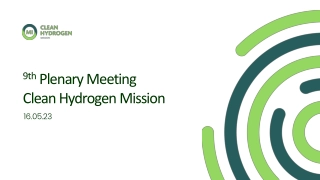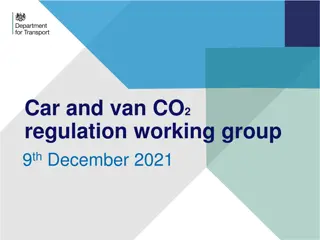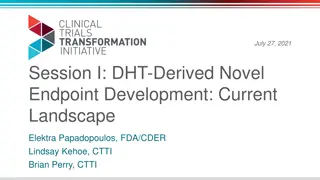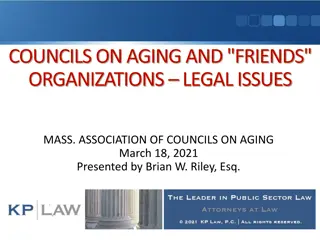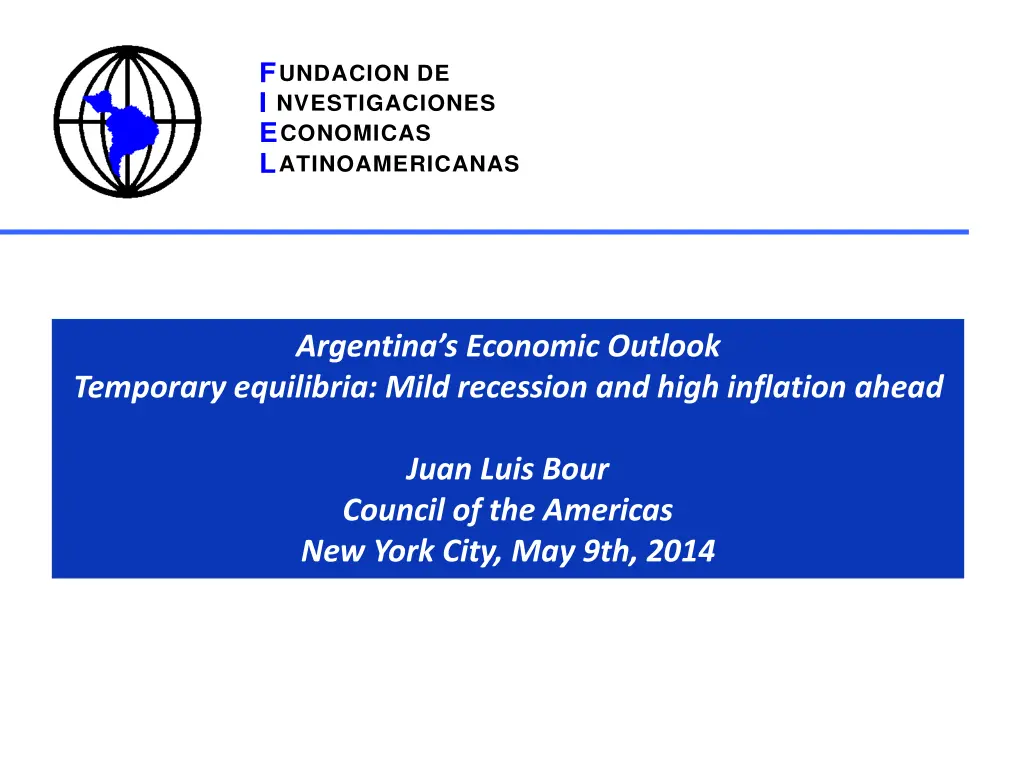
Argentina Economic Outlook 2014: Mild Recession and High Inflation
Explore the economic forecast for Argentina in 2014, predicting a mild recession and high inflation. Delve into the manufacturing and construction sectors, GDP trends, supply-side contributions to growth, trade statistics, and inflation challenges faced by the country. Gain insights into the temporary equilibria and potential strategies to address the economic situation.
Download Presentation

Please find below an Image/Link to download the presentation.
The content on the website is provided AS IS for your information and personal use only. It may not be sold, licensed, or shared on other websites without obtaining consent from the author. If you encounter any issues during the download, it is possible that the publisher has removed the file from their server.
You are allowed to download the files provided on this website for personal or commercial use, subject to the condition that they are used lawfully. All files are the property of their respective owners.
The content on the website is provided AS IS for your information and personal use only. It may not be sold, licensed, or shared on other websites without obtaining consent from the author.
E N D
Presentation Transcript
FUNDACION DE INVESTIGACIONES ECONOMICAS LATINOAMERICANAS Argentina s Economic Outlook Temporary equilibria: Mild recession and high inflation ahead Juan Luis Bour Council of the Americas New York City, May 9th, 2014
Manufacturing and Construction: 3 quarters of (sa) falls. Quarter to quarter % change (sa) Manufacturing Construction Quarter INDEC (EMI) FIEL (IPI) -1.6% -2.0% -0.6% INDEC (ISAC) -1.1% -1.2% -2.6% Q3 2013 Q4 2013 Q1 2014 -0.9% -2.0% -2.7%
GDP: fall (sa) since Q4 2013. (I) The demand side. Net exports (no growth contribution, except in 2014 because of major import fall) Investment: cyclical downturns in Equipment and Construction. Private consumption: from Consumption-led growth to adjustment.
(II) The supply side CONTRIBUTIONS TO GROWTH (percentage points, GDP at factor cost) Agriculture Manufacturing Construction Commerce, Hotels Financial Other services 2010 1.69 1.31 0.41 1.87 0.35 2.95 2011 0.20 0.65 0.50 0.97 1.13 3.11 2012 -0.73 -0.09 -0.18 -0.16 1.03 1.27 2013 0.37 0.09 0.06 0.25 0.54 1.53 2014 0.42 -0.83 -0.26 -0.53 0.15 0.36 (A) 2010-13 0.38 0.49 0.20 0.73 0.76 2.22 (B) 2014 - (A) 0.03 -1.32 -0.46 -1.26 -0.62 -1.85 No major contributions to growth since 2012 from Manufacturing, Construction and Commerce. Most sectors with a lower contribution to growth than average previous 4 years, except Agriculture. The main buffers in 2014, other than Agriculture: Transport &Communications, Financial sector.
The statistical nightmare Before After Difference Observ TRADE (billion USD) Exports (year) 83.03 81.66 -1.37 Billion USD Imports (year) 74.00 73.66 -0.34 Billion USD Trade Bal (year) 9.03 8.00 -1.03 Billion USD INFLATION (accumulated) % change CPI (Jan-March) 2.37 9.97 320.7% % change Supermarkets (Jan-March) 0.83 11.21 1258.2% GDP EMAE/GDP (year) 4.9 3.0 -1.9 pp
Whats behind trade figures? Exports stagnated since late 2010 Now they fall
Inflation close to 40% (yoy) Foods & Beverages >40% Short term deceleration Logistic curve: temporary stability around the new (higher) level
The antiinflation program: another temporary anchor (the ER)
Last year we warned on wage deceleration: impact on the consumption-led growth strategy. This year: wages as nominal anchor. The consumption boom is over.
FUNDACION DE INVESTIGACIONES ECONOMICAS LATINOAMERICANAS Undoing subsidies without regulatory reform Santiago Urbiztondo Council of the Americas New York City, May 9th, 2014
Public Utilities Context Since 2002, regulatory paradigm increasingly diverged from any broad best-practice ideal: Confusion of public and private roles Direct & discriminatory price regulation in competitive segments (upstream) Short-run (myopic) perspective, promoting inefficient operation / investment through cost-plus tariff / subsidy adjustments, discriminating old and new investments Disregard to transparency, institutional credibility, consistent contracts, technical analysis, etc.
Public Utilities Context Consequences: 1. Substantial reduction of (real) tariffs, covering a fraction of total (long-run) costs 2. Excessive consumption growth, but contraction of investments, exhausting existing capacity 3. Complications: exploding subsidies, poorly focalized, with deteriorating coverage, quality and cost 4. Perceived end of period: magnitude and composition of subsidies (energy imports) would require a major correction, reducing subsidies and increasing tariffs (and changing new paradigm)
Overall size & evolution of subsidies In 2013: subsidies to public utilities added USD 22 billions, or 4.4% of GDP CAMMESA & ENARSA: from 55% of total in 2009 to 73% in 2013 2014: First 2 moths explosive: total subsidies increased 13% in USD, approaching 5.7% of GDP without subsidy cuts Subsidies to public utilities (in MM USD and as % of GDP), 1989-2014p Source: Own elaboration based on SIGEP (1989-1995, MECON (1996-2003) and ASAP (2004-2014): Until 2003 it includes YPF, GE, AyEE, Hidronor, AA, FFAA, ELMA, ENTEL, ENCOTEL and OSN. Since 2004 it includes subsidies to public and private firms in the energy, transportation and W&S sectors. 2014p based on first 2months only (annual variation), and USD GDP growth is assumed at -13% . 25.000 6% 5% 20.000 4% 15.000 3% 10.000 2% 5.000 1% - 0% US$ (MM) % GDP (right axis)
Recent attempts to attack subsidies 1) New incentives (higher prices and promises) to YPF and other hydrocarbon producers since 2012, with no major results yet Evolution of gasoline and crude oil prices (average annual variation of USD values), 2005 - 2014 (months of march) Recovered prices of crude oil and gasoline before YPF s expropriation 30% 3% 2% 25% Stiff rise of new NG price since 2013 7.5 USD/MMBTU 1% 20% 0% 15% -1% 10% YPF s public profit function post-2012 (internalizing cost of subsidized energy) relative price recovery . -2% 5% -3% 0% -4% -5% -5% 2005-2009 2009-2011 2011-2012 2012-2014 YPF's monthly production: 2001 - March 2014 Source: Own elaboration based on SE. Price of domestic crude Price of gasoline -YPF Price YPF/ Price Rest (right axis) WTI Price of gasoline - Rest 1.800 1.600 1.400 certainly helped the new YPF to stop its previous production fall 1.200 1.000 800 600 Natural Gas (MM m3) Oil (1,000 m3)
Recent attempts to attack subsidies Recent attempts to attack subsidies 1) New incentives (higher prices and promises) to YPF and other hydrocarbon producers since 2012, with no major results yet Production of oil and natural gas: Yoy variation, Total, YPF and Rest, 2004-I.2014 Source: Own elaboration based on SE. Not effective to stop total market fall 10% 8% 6% Nor to induce higher investment effort (# of exploration and development wells drilled) 4% 2% 0% -2% Vaca Muerta? Announced investments still minor vis- -vis previous industry investment (5.2 billion USD in 2011). Substituting conventional oil and NG? -4% -6% -8% -10% Oil Total NG Total Oil YPF Oil Rest NG YPF NG Rest Number of development wells drilled, oil and natural gas, 2005-2014* Source: IAPG. * 2014 estimated with SE's aggregated data for first two months. Number of exploration wells drilled, oil and natural gas, 2005-2014* Source: IAPG. * 2014 estimated with SE's aggregated data for first two months. 300 180 160 250 140 200 120 100 150 80 100 60 40 50 20 0 0 Total YPF Rest Total YPF Rest
Recent attempts to attack subsidies Recent attempts to attack subsidies 2) AySA s tariff hike (nominally 170% to 405% according to location of user high, medium and low neighborhoods) is significant, but has a small impact on total subsidies and no effect on total costs under current de facto cost-plus regime with endogenous subsidy With average 310% nominal tariff increase, 35% inflation and 15% real devaluation in 2014, AySA s annual (post-august) subsidy falls 37% -USD 500 million , or 2.3% of overall 2013 subsidies to public utilities AySA's tariff and subsidy income, 2001 and 2006-2014* (in MM USD) Source: Own elaboration based on AASA, ERAS and INDEC. 1.600 1.400 Total elimination of subsidy to AySA would still require 170% additional tariff increases (with 2014 assumed USD costs) 1.200 1.000 800 600 400 200 0 2001 2006 2007 2008 2009 2010 2011 2012 2013 2014* Total income Tariff income Subsidy income
Recent attempts to attack subsidies Recent attempts to attack subsidies 3) Natural gas a) 2013 subsidies through ENARSA of 5.7 billion US$, 50% directed to residential (R) and commercial (C) users b) April 2014: partial withdrawal of subsidies to R and C, through higher wellhead prices, from +400% (<800 m3/year) to +900% (>1,800 m3/year), averaging 730% nominal AR$ increase (or 400% increase of cost of NG as large R users pay charge for imported gas), to be completed in August c) Price hikes avoided if consumption falls 20% vis- -vis previous year (hikes halved if consumption falls 5% - 20%) d) Effect on ENARSA s deficit unknown, but 25% is maximum reduction (as explicit subsidies informed to R users -1.0 billion USD- remain), i.e., 1.5 billion USD (or 6.9 % of total 2013 subsidies) e) Also, increases of T&D tariffs to same users (130% average, nominal ARG$, same distribution, avoiding mechanism and timing) f) 60% of NG exempted (industrial users, generators, Patagonia s R&C)
Recent attempts to attack subsidies Recent attempts to attack subsidies 3) NG: distortive upstream NG prices for residential users Upstream NG prices (w/o Decree 2067) increased much more for large R users, but % changes become more homogenous +/- 380% considering final cost of NG (including estimated payments under Decree 2067/08) Upstream NG price for Residential users, with and without Decree 2067/08's charges (USD/MMBTU) Source: Own elaboration based on Resolutions ENARGAS 1982/11 and SE 226/14. Exchange rate 8 $/US$ in March and 8.5 $/US$ in August. 6 5 4 3 2 1 - R1 R21 R22 R23 R31 R32 R33 R34 Prom R* March 2014, w/o Decree 2067 August 2014, w/o Decree 2067 March 2014, with Decree 2067 August 2014, with Decree 2067
Recent attempts to attack subsidies Recent attempts to attack subsidies 3) NG: full-year effect of various changes on Discos R&C users In USD, direct payment by NG users post-august 2014 would be 3% higher than in 2001, and total cost of NG service provided by Discos 25% higher Subsidy falling from 52% to 19% of total cost of R&C NG service Still, USD T&D margins are 50% lower than in 2001, and upstream cost of NG is 70% lower than imports from Bolivia (10 USD/MMBTU) NG price and cost to users served by distribution companies, in USD per user/year, 1993-2014* Source: Own elaboration based on ENARGAS and ASAP. * Year 2014 assumes 5% lower consumption, 70% higher constant $ T&D margins, 490% higher real $ upstream price paid by Disco users (but no change in not subsidized portion of Decree 2067/08) and 50% reduced constant $ subsidies (with 35% inflation and 15% real exchange rate devaluation). 1.000 60% 900 50% 800 700 40% 600 500 30% 400 20% 300 200 10% 100 0 0% Net sales T&D Subsidy to Disco users through ENARSA NG expenditure by "average Disco user" Cost of gas upstream Total cost Subsidy (as % of total cost, right axis)
Conclusions Conclusions 1. In 2014 the government finally recognized the inconsistency of its regulatory paradigm: fiscal needs call for tariff hikes Yet, overall fiscal impact is estimated low (total subsidies fall 9%) Also, tariff hikes are ill-designed: High impact on R&C, but many high-consumption users exempted Highly distortive, increasing discrimination across users through price signals (instead of fixed ARG$ breaks for a social tariff focus group) Unknown follow up: R s USD T&D tariffs still 50% below 2001; cost of wellhead NG at 3.1 USD/MMBTU for R still 70% below imported NG Does not include overall restatement of incentives, contracts, institutions, etc., to approach some form of best practice Beyond 2015, moving to cost-reflective prices and a more efficient new regulatory paradigm will still be politically difficult (less than in march), but it promises great efficiency (cost-reducing) rewards 2. 3. 4.
FUNDACION DE INVESTIGACIONES ECONOMICAS LATINOAMERICANAS Fixing the Fiscal Deficit Daniel Artana Council of the Americas New York City, May 9th, 2014
The problems at the end of 2013 High Fiscal Deficit financed with money emission and the use of Central Bank reserves High Inflation Appreciated Peso in real terms Pervasive distortions of relative prices Controls fatigue
The government strategy to fix the fisc Reduction in subsidies to energy: low fiscal impact Reduction of transfers to provinces: Limited by wage hikes for provincial employees Reduction of pensions and wages in real terms: seems to be the source to compensate the impact of the recession on tax collections
Federal Public Debt (% of GDP) 60 50 40 30 20 10 0 Net debt Central Bank Anses Contingent in Fgn Currency Contingent with pensioners
Federal Public Debt (% of GDP) Federal Public Debt (% of GDP) 60 60 Lower than Brazil s Gross 50 50 40 40 Net Debt 30 30 20 20 10 10 0 0 Net debt Net debt Central Bank Central Bank Anses Anses Contingent in Fgn Currency Contingent in Fgn Currency Contingent with pensioners Contingent with pensioners
Projection with 30% increase in 2014 (Arg $ 100 billion). Purchases of foreign exchange +20, Public Sector + 135 Lebacs/Nobacs -55
What would provide relief to the economy 1. An agreement with the Paris Club 2. Investments to develop non-conventional natural gas and oil 3. New foreign loans (Federal or Provincial governments or Private Sector) What would create additional problems 1. More controls and more mistakes on policy options instead of measures to correct economic imbalances 2. A sizeable decline in reserves that frightens depositors 3. A US Supreme Court decision that rejects Argentina s appeals on the hold outs case
The opportunities ahead Large non-conventional gas and oil resources With adequate contractual regime sizeable investments are likely Getting back to normal
Argentina belongs to the low- investment group in the region
Ranking out of 148 countries. Looks at 12 indicators of competitiviness Average of Brazil, Chile, Colombia, Mexico, Peru & Uruguay is 60
FUNDACION DE INVESTIGACIONES ECONOMICAS LATINOAMERICANAS Thank you!



